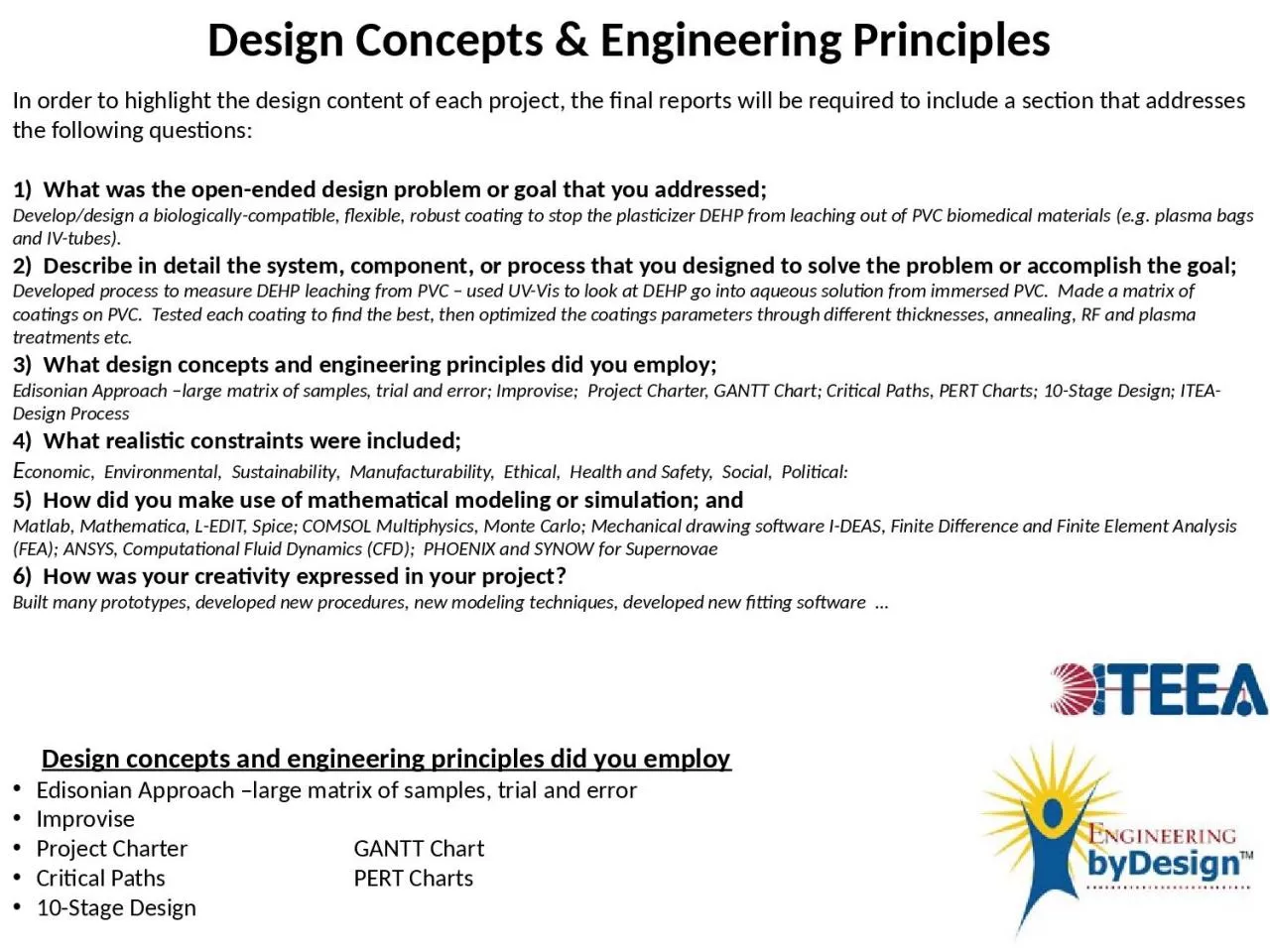

Design concepts and engineering principles did you employ Edisonian Approach large matrix of samples trial and error Improvise Project Charter GANTT Chart Critical Paths PERT ID: 931690
Download Presentation The PPT/PDF document "Design Concepts & Engineering Princi..." is the property of its rightful owner. Permission is granted to download and print the materials on this web site for personal, non-commercial use only, and to display it on your personal computer provided you do not modify the materials and that you retain all copyright notices contained in the materials. By downloading content from our website, you accept the terms of this agreement.
Slide1
Design Concepts & Engineering Principles
Design concepts and engineering principles did you employEdisonian Approach –large matrix of samples, trial and error ImproviseProject Charter GANTT ChartCritical Paths PERT Charts10-Stage Design
In
order to highlight the design content of each project, the final reports
will
be required to include a section that addresses the following questions:
1) What
was the open-ended design problem or goal that you addressed;
Develop/design
a biologically-compatible, flexible, robust coating to stop the plasticizer DEHP from leaching out
of
PVC biomedical materials (e.g. plasma bags and IV-tubes
).
2) Describe
in detail the system, component, or process that you designed to solve the problem or accomplish the goal;
Developed process to measure DEHP leaching from PVC – used UV-Vis to look at DEHP go into aqueous solution from immersed PVC. Made a matrix of coatings on PVC. Tested each coating to find the best, then optimized the coatings parameters through different thicknesses, annealing, RF and plasma treatments etc.
3) What
design concepts and engineering principles did you employ;
Edisonian
Approach –large matrix of samples, trial and error; Improvise; Project Charter, GANTT Chart; Critical Paths, PERT Charts; 10-Stage Design; ITEA- Design
Process
4) What
realistic constraints were included;
E
conomic, Environmental, Sustainability, Manufacturability, Ethical, Health and Safety, Social, Political
:
5) How
did you make use of mathematical modeling or simulation; and
Matlab
,
Mathematica
, L-EDIT, Spice; COMSOL
Multiphysics
, Monte Carlo; Mechanical drawing software I-DEAS, Finite Difference and Finite Element Analysis (FEA); ANSYS, Computational Fluid Dynamics (CFD); PHOENIX and SYNOW for Supernovae
6) How
was your creativity expressed in your project?
Built many prototypes, developed new procedures, new modeling techniques, developed new fitting software …
Slide210-Stage Design –
OU AME 4163AME4163 Design ProcessFrom:AME 4163 Principles of Design –Engineering design process August 21,2013, Zahed
Siddique
Slide3Define the Problem
Brainstorm Possible Solutions
Research and Generate Ideas
Identify Criteria and
Constraints
Explore Possibilities
Select an Approach
Develop a Design Proposal
Make a Model or Prototype
Test and Evaluate the Design Refine the DesignCreate or Make SolutionCommunicate All Results
Engineering-Physics Design Process
– ITEEA Standards for Technological Literacy
Back to the Drawing Board
Iterate/Perfect
Iterate/Perfect
NOW
ITEEA
: INTERNATIONAL
TECHNOLOGY
AND
ENGINEERING
EDUCATORS
ASSOCIATION
http://www.iteea.org
/
WAS
ITEA
: INTERNATIONAL
TECHNOLOGY
EDUCATORS
ASSOCIATION
Slide410-Stage Design
Identify the problem/product innovation (1.)Define the working criteria/goals (4.)Research and gather data (3.)
Brainstorm / generate creative ideas (2.)
Analyze potential solutions (5.)
Develop and test models (7.,8.,9.)
Make the decision (6.)
Communication and specify (12.)
Implement and
commercialize
(11.)
Perform post-implementation review and assessment (--.)These Look better for a Productfrom “Engineering Your Future: A Comprehensive Introduction to Engineering “by William C. Oakes, Les L. Leone, Craig J. Gunn, John L. Gruender- Oxford University Press ISBN 0199797560
Define the problem (1.)
Brainstorm Possible
Solutions (4.)
Research
and Generate
Ideas (3.)
Identify
Criteria and
Constraints (4.)
Explore Possibilities (5.)
Select
an Approach
(7.)
Develop
a Design
Proposal (6.)
Make
a Model or
Prototype (6.)
Test &
Evaluate the Design
(6.)
Refine the
Design (--.)
Create or Make
Solution (9.)
Communicate Results (8.)
These look better for
Research– ITEA Standards for Technological Literacy
vs. 12-Stage Design